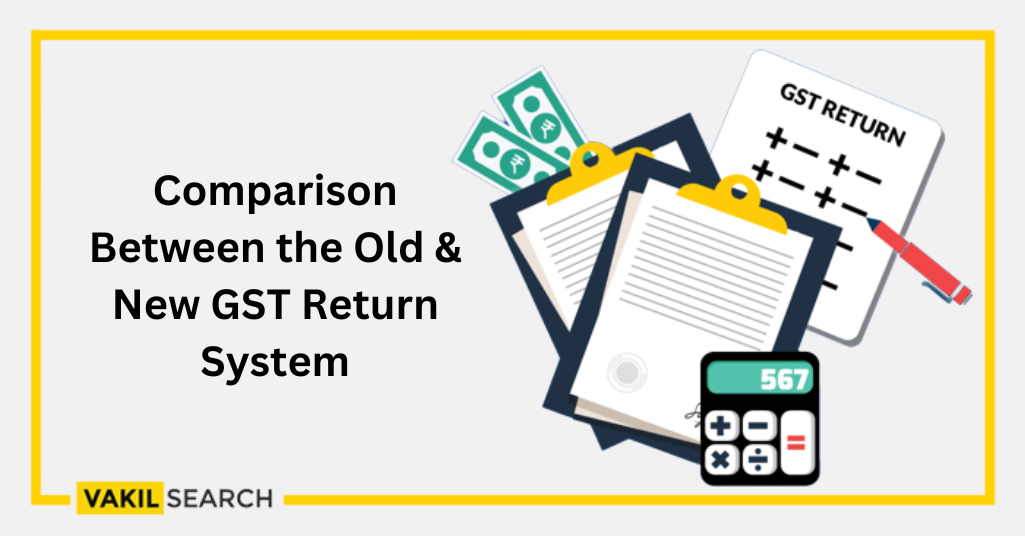New filings of return under GST offers improved speed, accuracy & ease of use compared to the old manual process. Reduces compliance burden & improves overall GST experience.
The GST return filing system is a crucial aspect of running a business in India and businesses are required to be compliant with the rules and regulations. By staying informed and utilizing the online platform, businesses can ensure accurate and hassle-free GST return filing. Through this article you will learn about the comparison between the old & new GST return filing system and the benefits of filing returns under GST system to businesses.
GST Return Filing System
The GST return filing system is an online platform that allows businesses to declare their sales and taxes owed to the government. It’s important for businesses to be aware of the GST return filing rules and regulations to avoid penalties and ensure compliance with the law.
Under the GST system, businesses are required to file returns on a monthly or quarterly basis, depending on their turnover. The GST return form consists of details such as sales, purchases, and taxes paid. The process of filing of returns under GST is straightforward, with a user-friendly interface and step-by-step instructions.
It’s important to note that businesses are required to keep accurate records of their sales and taxes to ensure accurate GST return filing. With the GST return filing system, businesses can view and download their previous filings, making it easier to manage their tax affairs.
Comparison between Old & New GST return filing system
The Goods and Services Tax (GST) system in India has undergone significant changes in recent years, particularly in the way returns are filed. The introduction of a new GST return filing system has brought about numerous improvements and made the process of declaring sales and taxes owed to the government more streamlined and efficient. In this blog, we’ll compare the old and new GST return filing system to understand the changes and improvements.
Old GST Return Filing System
Under the old GST filing system, businesses were required to file three returns every month – GSTR 1, GSTR 2, and GSTR 3. GSTR 1 was a record of sales, GSTR 2 was a record of purchases, and GSTR 3 was the final return that incorporated the details from both GSTR 1 and GSTR 2. This system was complicated and time-consuming, as businesses had to manually enter data in multiple forms. It was also prone to errors, making it difficult to reconcile the data and keep track of taxes owed to the government.
New GST Return Filing System
The new GST return filing system has introduced a single return form – GSTR 3B – that replaces the previous three returns. GSTR 3B consolidates the information from GSTR 1 and GSTR 2, making it easier for businesses to declare their sales and taxes owed to the government. The new system is more user-friendly and has a streamlined interface, with step-by-step instructions to guide businesses through the process. Additionally, the new system has improved the accuracy of data, reducing the possibility of errors and making it easier to reconcile the information.
Improvements in the New GST Return Filing System
Single Return Form
The introduction of a single return form, GSTR 3B, has made the process of declaring sales and taxes much simpler and more efficient. The consolidation of information from GSTR 1 and GSTR 2 eliminates the need to enter data in multiple forms, saving time and reducing the possibility of errors.
Improved Accuracy
The new GST return filing system has improved the accuracy of data by reducing the possibility of errors and making it easier to reconcile the information. The system is designed to minimize human error, ensuring that businesses can accurately declare their sales and taxes owed to the government.
User-Friendly Interface
The new system has a more user-friendly interface, with step-by-step instructions to guide businesses through the process. This makes it easier for businesses to understand the requirements and file their returns accurately.
Access to Previous Filings
It allows businesses to view and download their previous filings, making it easier to manage their tax affairs. This is particularly useful for businesses that need to refer to previous filings for reference or reconciliation purposes.
Real-time Reconciliation
The new system provides real-time reconciliation, allowing businesses to view and reconcile their tax details as soon as they are declared. This eliminates the need to wait for a response from the government and enables businesses to quickly resolve any issues that may arise.
Under the Old Return Filing System
Under the old GST return filing system, taxpayers were required to file three primary returns – GSTR-1, GSTR-2, and GSTR-3:
GSTR-1: This return involved the declaration of outward supplies made by the taxpayer during a specific period. It included details of sales, both to registered and unregistered persons.
GSTR-2: GSTR-2 was meant for providing information on the inward supplies received by the taxpayer. It was auto-populated based on the GSTR-1 filed by the counterparty.
GSTR-3: GSTR-3 was the consolidated return that auto-populated the tax liability, taking into account the details from GSTR-1 and GSTR-2. Taxpayers had to validate and make any additional changes before final submission.
Under the New Return Filing System
The new GST return filing system aims to simplify the process and reduce compliance burdens on taxpayers. It is based on a three-return cycle – GST RET-1 (Normal), GST RET-2 (Sahaj), and GST RET-3 (Sugam):
GST RET-1 (Normal): For regular taxpayers, GST RET-1 is applicable. It replaces GSTR-1 and requires taxpayers to report details of outward supplies, inward supplies attracting reverse charge, and import of goods and services.
GST RET-2 (Sahaj): GST Sahaj Returns RET-2 is meant for small taxpayers with a turnover up to ₹ 5 crores. It allows taxpayers to report outward supplies in a concise manner, making it easier for them to comply with GST requirements.
GST RET-3 (Sugam): GST RET-3 is for taxpayers with a turnover up to ₹ 5 crores engaged in the supply of both goods and services. It offers a simplified format for reporting outward supplies and inward supplies attracting reverse charge.
Comparison between Old & New GST Return Filing System
Let’s delve deeper into the key differences between the old and new GST return filing systems:
Return Filing Frequency
Old System: Under the old system, taxpayers had to file three returns every month – GSTR-1, GSTR-2, and GSTR-3. It resulted in a more frequent filing process.
New System: The new system follows a quarterly filing cycle for regular taxpayers. GST RET-1 is to be filed quarterly, which reduces the compliance burden significantly.
Auto-Population of Details
Old System: In the old system, GSTR-2 was auto-populated based on the data uploaded by the counterparty in their GSTR-1. This often led to discrepancies and mismatched data.
New System: The new system eliminates the auto-population of details in the GST returns. Taxpayers are required to upload their invoices, and there is no dependence on the counterparty’s filings.
Input Tax Credit (ITC) Mechanism
Old System: In the old system, ITC calculation was dependent on the GSTR-2 filed by the counterparty. Any discrepancies or non-filing of GSTR-2 could result in the denial of ITC.
New System: The new system introduces a new mechanism for ITC calculation. ITC will be available based on the invoices uploaded by the suppliers. Taxpayers can claim provisional credit immediately after uploading their purchase invoices.
Refunds and Filing of Annual Returns
Old System: Under the old system, taxpayers had to wait until the filing of the annual return (GSTR-9) to claim refunds for any excess tax paid.
New System: In the new system, taxpayers can claim refunds periodically by filing a new return – GST PMT-06. It allows for a more efficient and timely refund process.
Composition Scheme
Old System: The composition scheme was available for small taxpayers with a turnover of up to ₹ 1.5 crores in the goods category. However, these taxpayers were not allowed to make interstate supplies.
New System: The new system extends the composition scheme to service providers as well, allowing eligible taxpayers to opt for the composition scheme with a turnover limit of ₹ 1.5 crores. Additionally, they can make inter-state supplies under the scheme.
Additions Under the New GST Return Filing System
The new GST return filing system introduces several notable additions:
Sahaj and Sugam Returns: GST RET-2 (Sahaj) and GST RET-3 (Sugam) are new simplified returns introduced to cater to the specific needs of small taxpayers, making the process less cumbersome for them.
e-Invoicing: The new system mandates e-invoicing for taxpayers with a turnover of over ₹ 50 crores, which reduces the chances of errors and promotes a seamless data flow between businesses.
QRMP Scheme: The Quarterly Return Monthly Payment (QRMP) scheme is introduced for taxpayers with a turnover up to ₹ 5 crores. It allows them to file returns quarterly while paying taxes on a monthly basis.
Input Service Distributor (ISD) Return: The new system introduces a separate ISD return (GST ANX-2) for the Input Service Distributors to claim ITC.
FAQs on Comparison Between the Old & New GST Return System:
1. What is the difference between GST r1 and GST r2?
GST R1 (GSTR-1) is the return for declaring outward supplies, including details of sales made during a specific period. It is filed by the taxpayer to report the supplies made to registered and unregistered persons. On the other hand, GST R2 (GSTR-2) was the return for providing information on the inward supplies received by the taxpayer. It was auto-populated based on the GSTR-1 filed by the counterparty. Under the new GST return filing system, the concepts of GSTR-1 and GSTR-2 have been replaced by GST RET-1 (Normal), and the auto-population of data has been eliminated.
2. What is the difference between GSTR 2A and GSTR 2B?
GSTR-2A and GSTR-2B are both auto-generated documents that provide details of inward supplies to taxpayers: GSTR-2A: GSTR-2A is an auto-drafted return generated for recipients based on the information uploaded by their suppliers in their GSTR-1. GSTR-2B: GSTR-2B is an enhanced version of GSTR-2A. It includes additional details such as ITC eligibility, the impact of amendments, and ITC available on a real-time basis. GSTR-2B helps taxpayers to determine their ITC claims more accurately.
3. Which GST return is mandatory?
Under the new GST return filing system, the GST return that a taxpayer needs to file depends on their turnover and the nature of their supplies: Regular Taxpayers: Regular taxpayers with a turnover above ₹ 5 crores need to file GST RET-1 (Normal). Small Taxpayers: Small taxpayers with a turnover of up to ₹ 5 crores can opt for GST RET-1 (Normal), GST RET-2 (Sahaj), or GST RET-3 (Sugam) based on their eligibility and the nature of their supplies.
Conclusion
The introduction of the new GST return filing system has brought about numerous improvements and made the process of declaring sales and taxes more streamlined and efficient. The single return form, improved accuracy, user-friendly interface, access to previous filings, and real-time reconciliation have all made the process easier and more manageable for businesses. It’s important for businesses to stay informed and up-to-date with the latest GST return filing rules and regulations to ensure compliance and avoid penalties. Get expert advice at an affordable price at Vakilsearch where we deliver solutions to your queries within 24 hours.
Also, Read:










